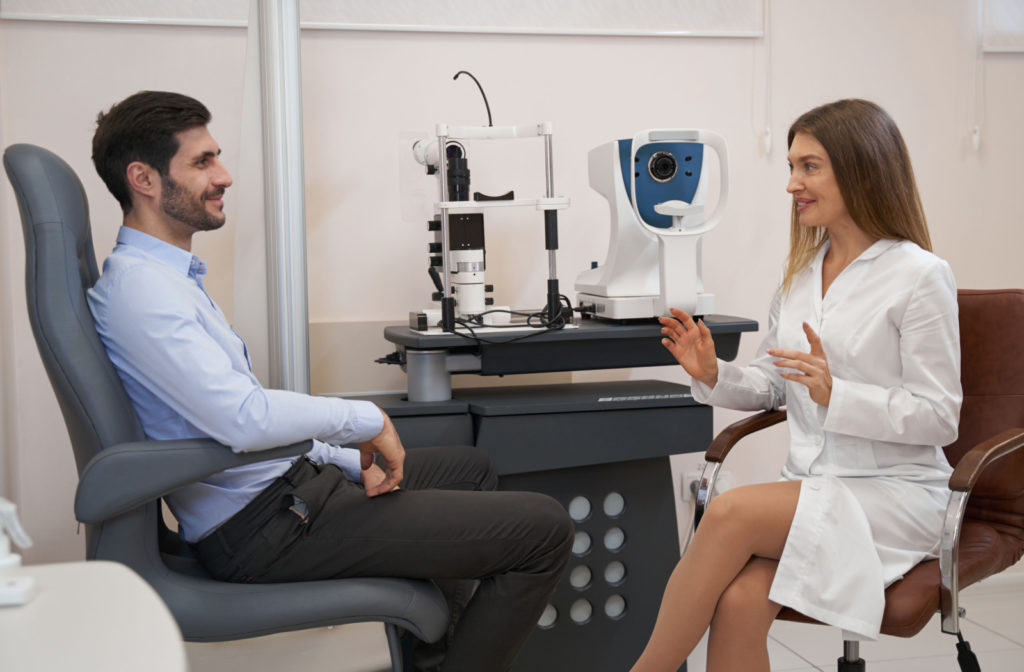Having a long-term vision problem can be frustrating. When you have a refractive error like nearsightedness or farsightedness, you know how much of an impact it can have on your life. Fortunately, corrective surgeries like LASIK or PRK offer more permanent solutions than glasses or contacts. But what’s the difference between these two procedures?
LASIK uses a precise laser incision to reshape the cornea. This surgery has a relatively short recovery time and is suitable for many candidates. PRK uses a special solution or brush to remove part of the cornea without an incision but has a longer recovery time than LASIK.
What Is LASIK?
LASIK stands for “laser-assisted in situ keratomileusis.” It’s a popular surgical procedure designed to correct your refractive error, like:
It aims to reduce or eliminate the need for eyeglasses and contact lenses by reshaping the cornea (the clear front part of your eye).
However, this surgery isn’t suitable for everyone. Results may differ depending on your unique eye situation, so it’s essential to consult with your optometrist to determine if you’re a candidate for this surgery.
How Does LASIK Work?
The LASIK procedure has a few steps:
- Numbing eye drops will be applied to your eyes to minimize discomfort.
- Your surgeon will use either a small handheld instrument or a laser to create a paper-thin flap on the surface of your eye.
- The flap is gently folded back to expose the underlying tissue.
- A precise laser is used to remove a small portion of tissue to reshape the eye and correct your vision error.
- The flap is repositioned, naturally sealing itself and healing over the next few days.
Typically, this entire process takes less than 20 minutes per eye. Fortunately, the recovery from this surgery does not take long. You can usually expect to regain your vision within a few days, though it may fluctuate while your eye heals. After a few weeks, your eyesight should be significantly improved.
What Is PRK?
PRK stands for “photorefractive keratectomy.” This surgical procedure was used before LASIK, even though it wasn’t formally approved for general use until 5 years after LASIK.
Like LASIK, PRK aims to reshape the cornea to correct refractive errors. However, while LASIK creates a flap, PRK gently removes the cornea’s outer layer using an alcohol solution or specially-designed brush to expose the underlying tissue.
Once the top layer is removed, a highly-precise laser reshapes the corneal tissue. After the surgery is complete, the cornea regrows over a period of a few days to a few weeks.
Since there is no flap or incision made during this surgery, PRK doesn’t have the potential complications as LASIK. PRK is also a better choice for those:
- With a thinner cornea than average.
- Who work in an environment where their eye is at risk of developing infection.
- Who regularly participate in high-impact or high-contact hobbies or sports.
Like LASIK, not everyone is a suitable candidate for PRK. You should always schedule a consultation with an optometrist before pursuing corrective eye surgery.
How Does PRK Work?
The PRK procedure follows these steps:
- Numbing eye drops are applied to the surface of your eyes to numb the area and minimize discomfort.
- The outer layer of the cornea, known as the epithelium, is gently removed with either an alcohol solution or brush.
- A laser is used to reshape the cornea and remove some of the exposed corneal tissue. The amount removed depends on your prescription and overall eye health.
- Once the surgery is complete, a bandage contact will be placed on your eye to help it heal. The cornea will regenerate over a period ranging from a few days to a few weeks.

What’s the Difference Between PRK & LASIK?
While these surgeries aim to reshape the cornea and restore your vision, they have some key differences.
LASIK features:
- An incision in the eye to access the underlying tissue
- A shorter recovery time
- Mild discomfort for a period of a day or 2 before the cornea begins to heal
- Quicker vision stabilization after the procedure
LASIK is also more suitable for a broader range of candidates but isn’t recommended for people with a thinner cornea or a high-contact lifestyle.
PRK features:
- Removal of the outer layer of the cornea without an incision
- A longer recovery time
- Increased light sensitivity or overall discomfort while healing
- Suitability for those with thinner corneas
- A longer time for vision to return to normal
Where to Get a Consultation for Laser Surgery
Both LASIK and PRK are safe, effective solutions for correcting vision problems. If you’re considering laser eye surgery, book an appointment with our Rancho Santa Margarita Optometry team. Our team of experienced staff can provide a thorough consultation and help determine if laser surgery is the right approach for you.


